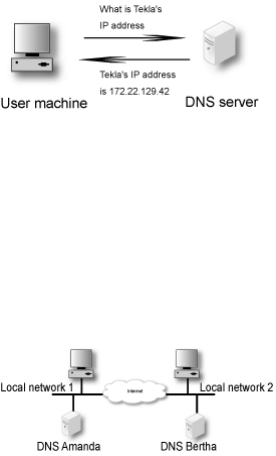
Appendix D. Definitions of terms
192.165.122.42. Several IP addresses are required to connect several computers in a network; one for each
computer.
IP addresses were previously divided into A networks, B networks and C networks, but that terminology is
now considered obsolete. An A network was one where the first group of numbers is predetermined and you
determine the remaining groups yourself; for example 17.x.y.z . A B network was one where the two first
groups are predetermined; for example 128.42.y.z. A C network was one where the first three groups are
predetermined; for example 192.168.12.z .
IP
IP stands for Internet Protocol. This is a protocol that is used to send data between two computers on the same
or different networks. IP performs no security checks. It works analogous to standard mail. Peter sends four
postcards to Christy from the other side of the world. Christy gets postcard two first, then postcard one and
postcard four. Postcard three disappears on the way. Peter and Christy know each other’s addresses, and the
post office knows how to read addresses and send postcards in the right direction. But Peter and Christy cannot
know if all of their postcards will arrive. And Christy doesn’t know what order the postcards were sent in.
For more information about IP addresses, see IP address.
Kerberos
Kerberos is a system to secure connections between several computers over networks. The Kerberos system
uses a Kerberos server to manage security. Connections that go through Kerberos are often encrypted.
Masquerading
See NAT.
Name server, DNS
A DNS server is the Internet equivalent of dialing telephone information. If you know the name of a computer,
you can access its IP address and vice versa. The server keeps track of names and IP addresses. Imagine that a
user wants to connect to the computer "Tekla" through a Telnet (terminal) connection. The Telnet program
asks the name server about Tekla and receives Tekla’s IP address. If the name server does not know a name, it
asks the nearest name server. See the figure.
Name servers are usually named primary, secondary, or other. If you have several networks with several name
servers, they can communicate with each other. It is a good idea to make them secondary name servers to each
other. Secondary name servers work as extra name servers if the primary server is not working.
A secondary name server updates its information from the primary name server at regular intervals. You can
specify how often. Only the manager of the name server can set it up as a secondary name server for someone
else. In the figure below, we have two local networks with separate name servers. If name server Amanda does
not work, a machine in network 1 may ask the name server in network 2, Bertha, if this server is set up as
secondary name server for Amanda. Other name servers outside network 1 and 2 belong to the other category.
The name server responds to name queries on port 53. Both TCP and UDP is used for name queries.
142


















